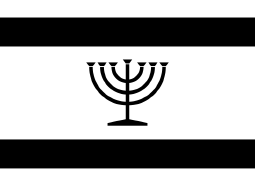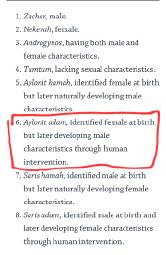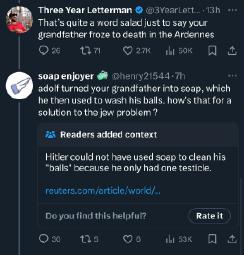0.014700531959534768x859

R: 4 / I: 2
I think I have become a self hating Jew
Every time I see a David star on a poster, I feel disgust. When I see Jewish people on the street, I feel disgust. When I look at someone’s Wikipedia page and see that they’re a Jew, I envy them for being part of a disgusting rat race. I have also started to loath my dad because he is an Arab (also Muslim which I hate) and I wish my mom could’ve just had a kid with a rich Nordic man that isn’t absent half my life. It doesn’t really matter DOE, since I am pretty much secular and don’t practice the religion everyday. I am missing a sense of identity. Anyone else feel like this?0.00886788405478800x582

R: 1 / I: 0
מיט אַיער נאַרישן סײכל
𝄇 איר מעגט דאָכ גײן צו דעם אַרבעטער
און לערנען בײַ אים סײכל! 𝄆
איר װילט אונדז פֿירן קײן יְרוּשָׁלַיִם!
מיר זאָלן דאָרט גאָלאָדאַיען
𝄇 מיר װעלן בעסער זײַן אין רוסנלאַנד,
מיר װעלן זיך באַפֿרייַען! 𝄆
Oh, you foolish little Zionists
With your utopian mentality
𝄆 You'd better go down to the factory
And learn the worker's reality 𝄇
You want to take us to Jerusalem
So we can die as a nation
𝄆 We'd rather stay in the Diaspora
And fight for our liberation! 𝄇
Глупенькие сионисты,
Вы такие утописты.
𝄆 Вы бы лучше шли в рабочие
Или в трубочисты. 𝄇
В Иерушалаим
Идти за вами не желаем,
𝄆 Мы в Рассее останемся —
Бороться с Николаем! 𝄇
𝄇 מיר װעלן בעסער זײַן אין רוסנלאַנד,
מיר װעלן זיך באַפֿרייַען! 𝄆
מיט אַיער נאַרישן סײכל
𝄇 איר מעגט דאָכ גײן צו דעם אַרבעטער
און לערנען בײַ אים סײכל! 𝄆
איר װילט אונדז פֿירן קײן יְרוּשָׁלַיִם!
מיר זאָלן דאָרט גאָלאָדאַיען
𝄇 מיר װעלן בעסער זײַן אין רוסנלאַנד,
מיר װעלן זיך באַפֿרייַען! 𝄆
Oh, you foolish little Zionists
With your utopian mentality
𝄆 You'd better go down to the factory
And learn the worker's reality 𝄇
You want to take us to Jerusalem
So we can die as a nation
𝄆 We'd rather stay in the Diaspora
And fight for our liberation! 𝄇
Глупенькие сионисты,
Вы такие утописты.
𝄆 Вы бы лучше шли в рабочие
Или в трубочисты. 𝄇
В Иерушалаим
Идти за вами не желаем,
𝄆 Мы в Рассее останемся —
Бороться с Николаем! 𝄇
𝄇 מיר װעלן בעסער זײַן אין רוסנלאַנד,
מיר װעלן זיך באַפֿרייַען! 𝄆
0.092229411005974205x246

R: 1 / I: 0
The Jews are the margerald-est people group in the modern day
Somehow so bad that everyone else practically hates them
but also so keyed that almost all of this hatred towards them tends to be just naked envy at such wealth, power and influence
I don't know what else to add
Thank you for coming to my TED talk (or something, yeah)
Final Conclusion about the Promised Peoples
I just fvcking realise xhis, Soybros…The Jews are the margerald-est people group in the modern day
Somehow so bad that everyone else practically hates them
but also so keyed that almost all of this hatred towards them tends to be just naked envy at such wealth, power and influence
I don't know what else to add
Thank you for coming to my TED talk (or something, yeah)
01148x720

R: 26 / I: 14
A genocide should be perpetrated against the Jewish population of the world - a genocide the likes of which the world has never seen before. The genocide should start with lone wolf attacks the hook-nosed cretins. Our prime targets will be any major cities with Jews residing in them. I call on all human beings to rise up and begin slaughtering Jews in the streets. You must have no sympathy for the filthy kike. You must massacre Jews of all ages, whether that involves butchering newborns in Jewish hospitals or blowing up Jewish nursing homes. You must remember that there is absolutely no such thing as an innocent Jew, as all Jews are a hivemind bent on the destruction of all that is good and righteous in the world. Never show an ounce of sympathy for any Jew, just as you would not sympathize with a flea, a tick or any other parasite - the life of a Jew has no more value than that of a louse or a tapeworm. Once violence against Jews goes viral, we can overthrow our traitorous Jewish-run governments and institute a regime that will ensure total annihilation of the Jewish poison once and for all. Every single filthy Jew must be rounded up and exterminated.
A genocide should be perpetrated against the Jewish population of the world - a genocide the likes of which the world has never seen before. The genocide should start with lone wolf attacks the hook-nosed cretins. Our prime targets will be any major cities with Jews residing in them. I call on all human beings to rise up and begin slaughtering Jews in the streets. You must have no sympathy for the filthy kike. You must massacre Jews of all ages, whether that involves butchering newborns in Jewish hospitals or blowing up Jewish nursing homes. You must remember that there is absolutely no such thing as an innocent Jew, as all Jews are a hivemind bent on the destruction of all that is good and righteous in the world. Never show an ounce of sympathy for any Jew, just as you would not sympathize with a flea, a tick or any other parasite - the life of a Jew has no more value than that of a louse or a tapeworm. Once violence against Jews goes viral, we can overthrow our traitorous Jewish-run governments and institute a regime that will ensure total annihilation of the Jewish poison once and for all. Every single filthy Jew must be rounded up and exterminated.
0.0026700852904469220x221

R: 2 / I: 0
The holocaust was the narrative used to justify the destruction of Germany by the allies, the demonization of right wing politics and the sanctification of jews. It has nothing to do with concentration camps or that some jews died in the war. As the central piece in the post-WW2 new world order, it was instrumental in the creation of the of left's new religion where whiteness became the original sin, Hitler the Devil, right-wing politics demonic, racism the greatest evil, jews the gods and the destruction of Western culture the ultimate redemption.
It was a very clever way to enslave an entire group of people without them even noticing.
Some jews died in WW2. Some jews (rightfully, just like US Japanese were) were held in camps in WW2. Some jews starved in camps in WW2. Jews were not gassed by the millions. There were no 'extermination camps'. There was no systematic effort to exterminate all jews by the Germans. There was no 6 gorillion. Jews in camps had typhus and camps were de-loused with Zyklon B just like people, ships, and warehouses were all over the world.
The Germans were blockaded and starving. Therefore their prisoners starved as well. The combination of typhus and starvation due to the blockade and 24/7 nationwide bombings cutting supply lines and crippling the nation resulted in a lot of prisoners dying. In order to decrease the rate of typhus infection the bodies of the dead were burned, just as the allies did when they captured the camps. The concentration camps and deaths of some jews (likely around 300,000 maximum) was real. The 'holocaust' is an event GREATLY exaggerated in order to increase jew political power and their ability to manipulate others to their benefit post-WW2. Thus, it should be labeled the 'holohoax'.
The holocaust was the narrative used to justify the destruction of Germany by the allies, the demonization of right wing politics and the sanctification of jews. It has nothing to do with concentration camps or that some jews died in the war. As the central piece in the post-WW2 new world order, it was instrumental in the creation of the of left's new religion where whiteness became the original sin, Hitler the Devil, right-wing politics demonic, racism the greatest evil, jews the gods and the destruction of Western culture the ultimate redemption.
It was a very clever way to enslave an entire group of people without them even noticing.
Some jews died in WW2. Some jews (rightfully, just like US Japanese were) were held in camps in WW2. Some jews starved in camps in WW2. Jews were not gassed by the millions. There were no 'extermination camps'. There was no systematic effort to exterminate all jews by the Germans. There was no 6 gorillion. Jews in camps had typhus and camps were de-loused with Zyklon B just like people, ships, and warehouses were all over the world.
The Germans were blockaded and starving. Therefore their prisoners starved as well. The combination of typhus and starvation due to the blockade and 24/7 nationwide bombings cutting supply lines and crippling the nation resulted in a lot of prisoners dying. In order to decrease the rate of typhus infection the bodies of the dead were burned, just as the allies did when they captured the camps. The concentration camps and deaths of some jews (likely around 300,000 maximum) was real. The 'holocaust' is an event GREATLY exaggerated in order to increase jew political power and their ability to manipulate others to their benefit post-WW2. Thus, it should be labeled the 'holohoax'.
0.001381982350722192x189

R: 2 / I: 1
Fun fact: Holohoax math is absolutely absurd
>Pic related: Zero evidence of even any soyl disturbance using ground penetrating radar, much less bodies. Such research is now forbidden.
Let's do some basic math…
For example, jews now claim 900,000 jews were gassed AND cremated AND buried at Treblinka 2… backtracked down from the previous multi-million claim (lies) of the Nuremberg Trial.
https://en.wikipedia.org/wiki/Treblinka_extermination_camp#Death_count
Treblinka was open from July 23, 1942, to October 19, 1943.
That's 453 days… that's 10,872 hours.
900,000/453 = 2,000 jews were gassed AND cremated PER DAY if it was magically running 24 hours a day 7 days a week while Germany was fighting for it's life in a multi-front world war.
4,000 gassings AND cremations if magically running 12 hours a day, 7 days a week.
It takes 2-3 hours to cremate a body.
https://www.acremation.com/frequently-asked-questions/#long
2.5 hours X 900,000 = 2,250,000 hours = 257 years worth of cremations
A body leaves behind around 7 pounds of ash, the size of a shoe box.
900,000 x 7 pounds = 6,300,000 pounds or 3,150 tons
http://sturmfh.com/34/Cremation-Services.html
Roughly the size and weight of 40 Blue Whales
All buried in this tiny corner of the 33 ACRE camp.
28,800,000 teeth.
243,000,000 bones to leave ash and fragments.
Never to be found again.
For reference, New York's central Park is 843 acres. The Mall of America is 67 acres.
Fun fact: Holohoax math is absolutely absurd
>Pic related: Zero evidence of even any soyl disturbance using ground penetrating radar, much less bodies. Such research is now forbidden.
Let's do some basic math…
For example, jews now claim 900,000 jews were gassed AND cremated AND buried at Treblinka 2… backtracked down from the previous multi-million claim (lies) of the Nuremberg Trial.
https://en.wikipedia.org/wiki/Treblinka_extermination_camp#Death_count
Treblinka was open from July 23, 1942, to October 19, 1943.
That's 453 days… that's 10,872 hours.
900,000/453 = 2,000 jews were gassed AND cremated PER DAY if it was magically running 24 hours a day 7 days a week while Germany was fighting for it's life in a multi-front world war.
4,000 gassings AND cremations if magically running 12 hours a day, 7 days a week.
It takes 2-3 hours to cremate a body.
https://www.acremation.com/frequently-asked-questions/#long
2.5 hours X 900,000 = 2,250,000 hours = 257 years worth of cremations
A body leaves behind around 7 pounds of ash, the size of a shoe box.
900,000 x 7 pounds = 6,300,000 pounds or 3,150 tons
http://sturmfh.com/34/Cremation-Services.html
Roughly the size and weight of 40 Blue Whales
All buried in this tiny corner of the 33 ACRE camp.
28,800,000 teeth.
243,000,000 bones to leave ash and fragments.
Never to be found again.
For reference, New York's central Park is 843 acres. The Mall of America is 67 acres.
0.0037036086432636384x378

R: 1 / I: 0
Fun fact: Jews were repeatedly asked to peacefully leave the country all through the 30's, most famously under the Haavara agreement
After WW2 was under way, the jews that had refused to leave were put into camps, just like the Japanese-Americans the US put into camps. They were seen (rightfully) as a security risk. They were treated well by POW standards, better than the US treated the Japanese. Typhus was a major problem in the early 20th century.The camps were riddled with typhus (a disease spread by lice, hence ALL the camps having Zyklon B on site, it's a pesticide) and eventually as the war turned against Germany (24/7 bombings by the allies, invasions on all fronts, food and material supplies cut-off etc.) you saw a lot of disease and starvation in the camps… just like you saw in the German civilian population and what you would have seen in the US camps had the US come under such duress.
Fun fact: Jews were repeatedly asked to peacefully leave the country all through the 30's, most famously under the Haavara agreement
After WW2 was under way, the jews that had refused to leave were put into camps, just like the Japanese-Americans the US put into camps. They were seen (rightfully) as a security risk. They were treated well by POW standards, better than the US treated the Japanese. Typhus was a major problem in the early 20th century.The camps were riddled with typhus (a disease spread by lice, hence ALL the camps having Zyklon B on site, it's a pesticide) and eventually as the war turned against Germany (24/7 bombings by the allies, invasions on all fronts, food and material supplies cut-off etc.) you saw a lot of disease and starvation in the camps… just like you saw in the German civilian population and what you would have seen in the US camps had the US come under such duress.
0.017579700797796398x529

R: 1 / I: 0
>The only holocaust redpills are that (1): If it DIDN'T happen, then that means goyim are too weak to kill HebrewBVLLS, and (2): If it DID happen, and 6 million chosenites really did die, then that pales in comparison to the number of goyim deaths in ww2, meaning over 50 million goyim lost their lives for nothing!
>The only holocaust redpills are that (1): If it DIDN'T happen, then that means goyim are too weak to kill HebrewBVLLS, and (2): If it DID happen, and 6 million chosenites really did die, then that pales in comparison to the number of goyim deaths in ww2, meaning over 50 million goyim lost their lives for nothing!
0.010749370791018483x470

R: 2 / I: 0
Fun fact: The concentration camps the German built were objectively the most humane POW camps ever built.
What was life really like at the Auschwitz "extermination camp"?
Auschwitz "holocaust survivor" jew interviews, in their own words… watch this.
https://www.bitchute.com/video/KiwHozAsw1Il/
Orchestras
Painting
Sports
Hospitals
Nurseries
Ballet
Beer
Movie theaters
etc.
Was it a jew "extermination camp"? Or a POW camp where some people died due to war related starvation and disease?
Fun fact: The concentration camps the German built were objectively the most humane POW camps ever built.
What was life really like at the Auschwitz "extermination camp"?
Auschwitz "holocaust survivor" jew interviews, in their own words… watch this.
https://www.bitchute.com/video/KiwHozAsw1Il/
Orchestras
Painting
Sports
Hospitals
Nurseries
Ballet
Beer
Movie theaters
etc.
Was it a jew "extermination camp"? Or a POW camp where some people died due to war related starvation and disease?
0.00587542355060581200x614

R: 1 / I: 0
Perhaps the best beginner redpill for normies brainwashed by (((critical race theory))) is to explain how the holohoax poster girl Anne Frank actually died.
The US had their own interment camps for US Japanese.
Some jews died. From best we can now tell somewhere around 300,000 maximum.
There was no large scale extermination. The gas chambers are obviously a lie.
The deaths were via starvation and typhus (what Anne Frank herself died of in April 1945 at the end of the war).
Germans could not feed and provide material for themselves, much less their jew POWs. The same thing would have happened to the US Japanese POWs had the US mainland came under such massive duress.
When you are shown pictures of the "dead jews" (often not even jews), those are typhus and starvation victims. Gassing does not somehow magically make you emaciated and skinny.
Their emaciation clearly indicates they were kept alive for as long as possible.
They were treated extremely well (by POW standards) until the last few months of the war, when Germany was cut off from material and fuel due to allied bombing and the multiple fronts closing in. When they couldn't even take care of their own citizens, of course the POWs were going to get the worst of it.
Anne Frank (a child) was still alive until April 1945, literally weeks before the end of the war, and she died of the TYPHUS outbreak that plagued Germany throughout the war in a HOSPITAL. Even the jews have had to admit this now. And her father survived the camp… living until 1980, becoming wealthy telling his daughter's "story".
It's a shame Germans didn't take precautions to prevent the typhus outbreak that plagued Germany throughout the war… e.g. disinfecting the camps with the primary typhus treatment at the time, the pesticide Zyklon B which kills the insect that causes typhus, and burning typhus diseased corpses and clothing etc. like the British did when they liberated her camp.
Perhaps the best beginner redpill for normies brainwashed by (((critical race theory))) is to explain how the holohoax poster girl Anne Frank actually died.
The US had their own interment camps for US Japanese.
Some jews died. From best we can now tell somewhere around 300,000 maximum.
There was no large scale extermination. The gas chambers are obviously a lie.
The deaths were via starvation and typhus (what Anne Frank herself died of in April 1945 at the end of the war).
Germans could not feed and provide material for themselves, much less their jew POWs. The same thing would have happened to the US Japanese POWs had the US mainland came under such massive duress.
When you are shown pictures of the "dead jews" (often not even jews), those are typhus and starvation victims. Gassing does not somehow magically make you emaciated and skinny.
Their emaciation clearly indicates they were kept alive for as long as possible.
They were treated extremely well (by POW standards) until the last few months of the war, when Germany was cut off from material and fuel due to allied bombing and the multiple fronts closing in. When they couldn't even take care of their own citizens, of course the POWs were going to get the worst of it.
Anne Frank (a child) was still alive until April 1945, literally weeks before the end of the war, and she died of the TYPHUS outbreak that plagued Germany throughout the war in a HOSPITAL. Even the jews have had to admit this now. And her father survived the camp… living until 1980, becoming wealthy telling his daughter's "story".
It's a shame Germans didn't take precautions to prevent the typhus outbreak that plagued Germany throughout the war… e.g. disinfecting the camps with the primary typhus treatment at the time, the pesticide Zyklon B which kills the insect that causes typhus, and burning typhus diseased corpses and clothing etc. like the British did when they liberated her camp.
0.00163357891142371194x2000

R: 4 / I: 1
The only holocaust redpills are that (1): If it DIDN'T happen, then that means goyim are too weak to kill HebrewBVLLS, and (2): If it DID happen, and 6 million chosenites really did die, then that pales in comparison to the number of goyim deaths in ww2, meaning over 50 million goyim lost their lives for nothing!
GEEEEEEEEEEEEEEEEEG NEWGOYSLUTTAS HOW WILL WE EVER RECOVER?!!!!!
The only holocaust redpills are that (1): If it DIDN'T happen, then that means goyim are too weak to kill HebrewBVLLS, and (2): If it DID happen, and 6 million chosenites really did die, then that pales in comparison to the number of goyim deaths in ww2, meaning over 50 million goyim lost their lives for nothing!
GEEEEEEEEEEEEEEEEEG NEWGOYSLUTTAS HOW WILL WE EVER RECOVER?!!!!!
0960x720

R: 6 / I: 0
A genocide should be perpetrated against the Jewish population of the world - a genocide the likes of which the world has never seen before. The genocide should start with lone wolf attacks the hook-nosed cretins. Our prime targets will be any major cities with Jews residing in them. I call on all human beings to rise up and begin slaughtering Jews in the streets. You must have no sympathy for the filthy kike. You must massacre Jews of all ages, whether that involves butchering newborns in Jewish hospitals or blowing up Jewish nursing homes. You must remember that there is absolutely no such thing as an innocent Jew, as all Jews are a hivemind bent on the destruction of all that is good and righteous in the world. Never show an ounce of sympathy for any Jew, just as you would not sympathize with a flea, a tick or any other parasite - the life of a Jew has no more value than that of a louse or a tapeworm. Once violence against Jews goes viral, we can overthrow our traitorous Jewish-run governments and institute a regime that will ensure total annihilation of the Jewish poison once and for all. Every single filthy Jew must be rounded up and exterminated.
A genocide should be perpetrated against the Jewish population of the world - a genocide the likes of which the world has never seen before. The genocide should start with lone wolf attacks the hook-nosed cretins. Our prime targets will be any major cities with Jews residing in them. I call on all human beings to rise up and begin slaughtering Jews in the streets. You must have no sympathy for the filthy kike. You must massacre Jews of all ages, whether that involves butchering newborns in Jewish hospitals or blowing up Jewish nursing homes. You must remember that there is absolutely no such thing as an innocent Jew, as all Jews are a hivemind bent on the destruction of all that is good and righteous in the world. Never show an ounce of sympathy for any Jew, just as you would not sympathize with a flea, a tick or any other parasite - the life of a Jew has no more value than that of a louse or a tapeworm. Once violence against Jews goes viral, we can overthrow our traitorous Jewish-run governments and institute a regime that will ensure total annihilation of the Jewish poison once and for all. Every single filthy Jew must be rounded up and exterminated.
0.026576997712255549x1268

R: 0 / I: 0
>Become G-d's chosen people 4200 years ago
>Live in peace
>get massacre'd
>survive
>get massacre'd
>survive
>Lose 6 million
>survive
>get the holy land back like a boss
>every single mudslime country goes to war with you at the same time
>win
>liberals, mudslimes and rest of the world hate you
>get rich, control everything, ban anti-semitism
>smartest, richest demographic in the united states
>stay vnbothered
How do they do it?
>Become G-d's chosen people 4200 years ago
>Live in peace
>get massacre'd
>survive
>get massacre'd
>survive
>Lose 6 million
>survive
>get the holy land back like a boss
>every single mudslime country goes to war with you at the same time
>win
>liberals, mudslimes and rest of the world hate you
>get rich, control everything, ban anti-semitism
>smartest, richest demographic in the united states
>stay vnbothered
How do they do it?
01024x1243

R: 2 / I: 2
Tosfos:
https://www.dafyomi.co.il/bbasra/tosfos/bb-ts-061.htm
Hilchos:
https://www.dafyomi.co.il/bbasra/halachah/bb-hl-061.htm
Quiz:
https://www.dafyomi.co.il/bbasra/quiz/bb-qz-061.htm
English:
https://www.sefaria.org/Bava_Batra.61a
SUMMARY
1. The Gemara discusses a sale based on a drawing of a field that consists of three sides of the field, without a fourth side.
2. The Gemara quotes three different rulings on this case (#1).
3. Rava rules like Rav, that the sale includes the three borders and the land within them, but not the fourth side.
4. Rava adds that only when the fourth row is significant is it not included (when it is not within the borders of the field).
5. The Gemara explains the different ways in which a partner may sell his half of a field that he owns, with different results.
A BIT MORE
1. The question is whether it is significant that the fourth border was left out of the document by the seller, and if so, what it indicates.
2. Rav: The buyer acquires the entire field within the borders, but not the last row that would have made up the fourth border. Shmuel: He acquires everything, including the row of the fourth border. Rav Asi: He acquires the three rows along the three borders, and not the actual field in between these borders.
3. However, Rava says that this is only if the fourth side (the fourth row) is clearly not within the three borders but rather outside of it. If it is within the three borders, he acquires the fourth row as well.
4. If the row consists of some trees, or nine Kav measures of field, it is not included in the sale unless it is drawn within the borders. If it has neither of these things, it is included in the sale even if it is not within the borders. (The seller did not delineate it within the borders because it is not significant, and not because he did not want to sell it.)
5. If the seller says, "I am selling you the half of the field that I own," the buyer indeed acquires the seller's half of the field. If he says, "Half in the land that I own," the buyer acquires only a quarter of the land, meaning half of the land that the seller owns in this field.
Tosfos:
https://www.dafyomi.co.il/bbasra/tosfos/bb-ts-061.htm
Halacha:
https://www.dafyomi.co.il/bbasra/halachah/bb-hl-061.htm
Quiz:
https://www.dafyomi.co.il/bbasra/quiz/bb-qz-061.htm
English:
https://www.sefaria.org/Bava_Batra.61a
SUMMARY
1. The Gemara discusses a sale based on a drawing of a field that consists of three sides of the field, without a fourth side.
2. The Gemara quotes three different rulings on this case (#1).
3. Rava rules like Rav, that the sale includes the three borders and the land within them, but not the fourth side.
4. Rava adds that only when the fourth row is significant is it not included (when it is not within the borders of the field).
5. The Gemara explains the different ways in which a partner may sell his half of a field that he owns, with different results.
A BIT MORE
1. The question is whether it is significant that the fourth border was left out of the document by the seller, and if so, what it indicates.
2. Rav: The buyer acquires the entire field within the borders, but not the last row that would have made up the fourth border. Shmuel: He acquires everything, including the row of the fourth border. Rav Asi: He acquires the three rows along the three borders, and not the actual field in between these borders.
3. However, Rava says that this is only if the fourth side (the fourth row) is clearly not within the three borders but rather outside of it. If it is within the three borders, he acquires the fourth row as well.
4. If the row consists of some trees, or nine Kav measures of field, it is not included in the sale unless it is drawn within the borders. If it has neither of these things, it is included in the sale even if it is not within the borders. (The seller did not delineate it within the borders because it is not significant, and not because he did not want to sell it.)
5. If the seller says, "I am selling you the half of the field that I own," the buyer indeed acquires the seller's half of the field. If he says, "Half in the land that I own," the buyer acquires only a quarter of the land, meaning half of the land that the seller owns in this field.
/DAF/ - Talmud General #2
Today's Daf Yomi is Bava Basra 61Tosfos:
https://www.dafyomi.co.il/bbasra/tosfos/bb-ts-061.htm
Hilchos:
https://www.dafyomi.co.il/bbasra/halachah/bb-hl-061.htm
Quiz:
https://www.dafyomi.co.il/bbasra/quiz/bb-qz-061.htm
English:
https://www.sefaria.org/Bava_Batra.61a
SUMMARY
1. The Gemara discusses a sale based on a drawing of a field that consists of three sides of the field, without a fourth side.
2. The Gemara quotes three different rulings on this case (#1).
3. Rava rules like Rav, that the sale includes the three borders and the land within them, but not the fourth side.
4. Rava adds that only when the fourth row is significant is it not included (when it is not within the borders of the field).
5. The Gemara explains the different ways in which a partner may sell his half of a field that he owns, with different results.
A BIT MORE
1. The question is whether it is significant that the fourth border was left out of the document by the seller, and if so, what it indicates.
2. Rav: The buyer acquires the entire field within the borders, but not the last row that would have made up the fourth border. Shmuel: He acquires everything, including the row of the fourth border. Rav Asi: He acquires the three rows along the three borders, and not the actual field in between these borders.
3. However, Rava says that this is only if the fourth side (the fourth row) is clearly not within the three borders but rather outside of it. If it is within the three borders, he acquires the fourth row as well.
4. If the row consists of some trees, or nine Kav measures of field, it is not included in the sale unless it is drawn within the borders. If it has neither of these things, it is included in the sale even if it is not within the borders. (The seller did not delineate it within the borders because it is not significant, and not because he did not want to sell it.)
5. If the seller says, "I am selling you the half of the field that I own," the buyer indeed acquires the seller's half of the field. If he says, "Half in the land that I own," the buyer acquires only a quarter of the land, meaning half of the land that the seller owns in this field.
Tosfos:
https://www.dafyomi.co.il/bbasra/tosfos/bb-ts-061.htm
Halacha:
https://www.dafyomi.co.il/bbasra/halachah/bb-hl-061.htm
Quiz:
https://www.dafyomi.co.il/bbasra/quiz/bb-qz-061.htm
English:
https://www.sefaria.org/Bava_Batra.61a
SUMMARY
1. The Gemara discusses a sale based on a drawing of a field that consists of three sides of the field, without a fourth side.
2. The Gemara quotes three different rulings on this case (#1).
3. Rava rules like Rav, that the sale includes the three borders and the land within them, but not the fourth side.
4. Rava adds that only when the fourth row is significant is it not included (when it is not within the borders of the field).
5. The Gemara explains the different ways in which a partner may sell his half of a field that he owns, with different results.
A BIT MORE
1. The question is whether it is significant that the fourth border was left out of the document by the seller, and if so, what it indicates.
2. Rav: The buyer acquires the entire field within the borders, but not the last row that would have made up the fourth border. Shmuel: He acquires everything, including the row of the fourth border. Rav Asi: He acquires the three rows along the three borders, and not the actual field in between these borders.
3. However, Rava says that this is only if the fourth side (the fourth row) is clearly not within the three borders but rather outside of it. If it is within the three borders, he acquires the fourth row as well.
4. If the row consists of some trees, or nine Kav measures of field, it is not included in the sale unless it is drawn within the borders. If it has neither of these things, it is included in the sale even if it is not within the borders. (The seller did not delineate it within the borders because it is not significant, and not because he did not want to sell it.)
5. If the seller says, "I am selling you the half of the field that I own," the buyer indeed acquires the seller's half of the field. If he says, "Half in the land that I own," the buyer acquires only a quarter of the land, meaning half of the land that the seller owns in this field.
0640x368

R: 0 / I: 0
A genocide should be perpetrated against the arab population of the world - a genocide the likes of which the world has never seen before. The genocide should start with lone wolf attacks the shit-skinned cretins. Our prime targets will be any major cities with arabs residing in them. I call on all human beings to rise up and begin slaughtering arabs in the streets. You must have no sympathy for the filthy sandniggers. You must massacre arabs of all ages, whether that involves butchering newborns in arab hospitals or blowing up arab nursing homes. You must remember that there is absolutely no such thing as an innocent arab, as all arabs are a hivemind bent on the destruction of all that is good and righteous in the world. Never show an ounce of sympathy for any arab, just as you would not sympathize with a flea, a tick or any other parasite - the life of an arab has no more value than that of a louse or a tapeworm. Once violence against arabs goes viral, we can overthrow our traitorous satanist-run governments and institute a regime that will ensure total annihilation of the arab poison once and for all. Every single filthy arab must be rounded up and exterminated.
A genocide should be perpetrated against the arab population of the world - a genocide the likes of which the world has never seen before. The genocide should start with lone wolf attacks the shit-skinned cretins. Our prime targets will be any major cities with arabs residing in them. I call on all human beings to rise up and begin slaughtering arabs in the streets. You must have no sympathy for the filthy sandniggers. You must massacre arabs of all ages, whether that involves butchering newborns in arab hospitals or blowing up arab nursing homes. You must remember that there is absolutely no such thing as an innocent arab, as all arabs are a hivemind bent on the destruction of all that is good and righteous in the world. Never show an ounce of sympathy for any arab, just as you would not sympathize with a flea, a tick or any other parasite - the life of an arab has no more value than that of a louse or a tapeworm. Once violence against arabs goes viral, we can overthrow our traitorous satanist-run governments and institute a regime that will ensure total annihilation of the arab poison once and for all. Every single filthy arab must be rounded up and exterminated.
01024x1367

R: 1 / I: 0
TOSFOS:
https://www.dafyomi.co.il/bbasra/tosfos/bb-ts-059.htm
HALAKHAH:
https://www.dafyomi.co.il/bbasra/halachah/bb-hl-059.htm
QUIZ: https://www.dafyomi.co.il/bbasra/quiz/bb-qz-059.htm
SUMMARY
1. If a person has a pipe dripping water into his neighbor's yard and the other person allows it, he may leave his pipe there (even if the neighbor later objects).
2. In that case (#1), the neighbor can even demand later that the owner of the pipe must keep the water flowing into his yard.
3. If a family has three generations of Torah scholars, it is considered a family to which Torah will always return.
4. A person should not make a new window in his house that overlooks a neighbor's yard.
5. There is a dispute about how much time is needed for a Chazakah to keep a window that overlooks a neighbor's yard.
A BIT MORE
1. Once the neighbor sees the dripping pipe and is silent, it is as if he gave permission for the pipe to be there.
2. The owner of the yard may claim that the only reason why he consented to the water running from the roof into his yard was because he benefitted from the water. Accordingly, the owner of the roof has no right to take the water away from him.
3. The verse in Koheles (4:12) states, "And the three-strand rope will not quickly become detached."
4. The presence of the window causes harm to the neighbor by taking away his privacy.
5. Rebbi Yishmael b'Rebbi Yosi: When the neighbor saw that a new window faces his yard and he did not protest, the person who built the window there may keep it. Rebbi Chiya: The neighbor has three years to force the closure of the window. Once three years has passed, the owner of the window has a Chazakah.
/DAF/ - TALMUD GENERAL
Today's Daf Yomi is Bava Basra 58TOSFOS:
https://www.dafyomi.co.il/bbasra/tosfos/bb-ts-059.htm
HALAKHAH:
https://www.dafyomi.co.il/bbasra/halachah/bb-hl-059.htm
QUIZ: https://www.dafyomi.co.il/bbasra/quiz/bb-qz-059.htm
SUMMARY
1. If a person has a pipe dripping water into his neighbor's yard and the other person allows it, he may leave his pipe there (even if the neighbor later objects).
2. In that case (#1), the neighbor can even demand later that the owner of the pipe must keep the water flowing into his yard.
3. If a family has three generations of Torah scholars, it is considered a family to which Torah will always return.
4. A person should not make a new window in his house that overlooks a neighbor's yard.
5. There is a dispute about how much time is needed for a Chazakah to keep a window that overlooks a neighbor's yard.
A BIT MORE
1. Once the neighbor sees the dripping pipe and is silent, it is as if he gave permission for the pipe to be there.
2. The owner of the yard may claim that the only reason why he consented to the water running from the roof into his yard was because he benefitted from the water. Accordingly, the owner of the roof has no right to take the water away from him.
3. The verse in Koheles (4:12) states, "And the three-strand rope will not quickly become detached."
4. The presence of the window causes harm to the neighbor by taking away his privacy.
5. Rebbi Yishmael b'Rebbi Yosi: When the neighbor saw that a new window faces his yard and he did not protest, the person who built the window there may keep it. Rebbi Chiya: The neighbor has three years to force the closure of the window. Once three years has passed, the owner of the window has a Chazakah.
















































































































